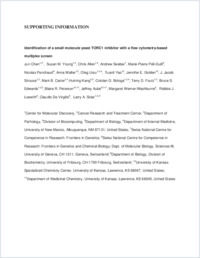Identification of a small molecule yeast TORC1 inhibitor with a multiplex screen based on flow cytometry
- Chen, Jun Center for Molecular Discovery, University of New Mexico, Albuquerque, USA - Cancer Research and Treatment Center, University of New Mexico, Albuquerque, USA
- Young, Susan M. Center for Molecular Discovery, University of New Mexico, Albuquerque, USA - Cancer Research and Treatment Center, University of New Mexico, Albuquerque, USA
- Allen, Chris Center for Molecular Discovery, University of New Mexico, Albuquerque, USA - Cancer Research and Treatment Center, University of New Mexico, Albuquerque, USA
- Seeber, Andrew Swiss National Centre for Competence in Research: Frontiers in Genetics, Sciences III, University of Geneva, Switzerland
- Péli-Gulli, Marie-Pierre Department of Biology, Division of Biochemistry, University of Fribourg, Switzerland
- Panchaud, Nicolas Department of Biology, Division of Biochemistry, University of Fribourg, Switzerland
- Waller, Anna Center for Molecular Discovery, University of New Mexico, Albuquerque, USA - Cancer Research and Treatment Center, University of New Mexico, Albuquerque, USA
- Ursu, Oleg Center for Molecular Discovery, University of New Mexico, Albuquerque, USA - Cancer Research and Treatment Center, University of New Mexico, Albuquerque, USA
- Yao, Tuanli University of Kansas Specialized Chemistry Center, Lawrence, USA
- Golden, Jennifer E. University of Kansas Specialized Chemistry Center, Lawrence, USA
- Strouse, J. Jacob Center for Molecular Discovery, University of New Mexico, Albuquerque, USA - Cancer Research and Treatment Center, University of New Mexico, Albuquerque, USA
- Carter, Mark B. Center for Molecular Discovery, University of New Mexico, Albuquerque, USA - Cancer Research and Treatment Center, University of New Mexico, Albuquerque, USA
- Kang, Huining Cancer Research and Treatment Center, University of New Mexico, Albuquerque, USA - Department of Internal Medicine, University of New Mexico, Albuquerque, USA
- Bologa, Cristian G. Center for Molecular Discovery, University of New Mexico, Albuquerque, USA - Cancer Research and Treatment Center, University of New Mexico, Albuquerque, USA
- Foutz, Terry D. Center for Molecular Discovery, University of New Mexico, Albuquerque, USA - Cancer Research and Treatment Center, University of New Mexico, Albuquerque, USA
- Edwards, Bruce S. Center for Molecular Discovery, University of New Mexico, Albuquerque, USA - Cancer Research and Treatment Center, University of New Mexico, Albuquerque, USA - Department of Pathology, University of New Mexico, Albuquerque, USA
- Peterson, Blake R. University of Kansas Specialized Chemistry Center, Lawrence, USA - Department of Medicinal Chemistry, University of Kansas, Lawrence, USA
- Aubé, Jeffrey University of Kansas Specialized Chemistry Center, Lawrence, USA - Department of Medicinal Chemistry, University of Kansas, Lawrence, USA
- Werner-Washburne, Margaret Department of Biology, University of New Mexico, Albuquerque, USA
- Loewith, Robbie J. Swiss National Centre for Competence in Research: Frontiers in Genetics and Chemical Biology
- De Virgilio, Claudio Department of Biology, Division of Biochemistry, University of Fribourg, Switzerland
- Sklar, Larry A. Center for Molecular Discovery, University of New Mexico, Albuquerque, USA - Cancer Research and Treatment Center, University of New Mexico, Albuquerque, USA - Department of Pathology, University of New Mexico, Albuquerque, USA
-
19.01.2012
Published in:
- ACS Chemical Biology. - 2012, vol. 7, no. 4, p. 715–722
English
TOR (target of rapamycin) is a serine/threonine kinase, evolutionarily conserved from yeast to human, which functions as a fundamental controller of cell growth. The moderate clinical benefit of rapamycin in mTOR-based therapy of many cancers favors the development of new TOR inhibitors. Here we report a high-throughput flow cytometry multiplexed screen using five GFP-tagged yeast clones that represent the readouts of four branches of the TORC1 signaling pathway in budding yeast. Each GFP-tagged clone was differentially color-coded, and the GFP signal of each clone was measured simultaneously by flow cytometry, which allows rapid prioritization of compounds that likely act through direct modulation of TORC1 or proximal signaling components. A total of 255 compounds were confirmed in dose–response analysis to alter GFP expression in one or more clones. To validate the concept of the high- throughput screen, we have characterized CID 3528206, a small molecule most likely to act on TORC1 as it alters GFP expression in all five GFP clones in a manner analogous to that of rapamycin. We have shown that CID 3528206 inhibited yeast cell growth and that CID 3528206 inhibited TORC1 activity both in vitro and in vivo with EC50's of 150 nM and 3.9 μM, respectively. The results of microarray analysis and yeast GFP collection screen further support the notion that CID 3528206 and rapamycin modulate similar cellular pathways. Together, these results indicate that the HTS has identified a potentially useful small molecule for further development of TOR inhibitors.
- Faculty
- Faculté des sciences et de médecine
- Department
- Département de Biologie
- Language
-
- English
- Classification
- Biological sciences
- License
-
License undefined
- Identifiers
-
- RERO DOC 29096
- DOI 10.1021/cb200452r
- Persistent URL
- https://folia.unifr.ch/unifr/documents/302314
Other files
Statistics
Document views: 118
File downloads:
- pdf: 204
- Supplementary material: 161

